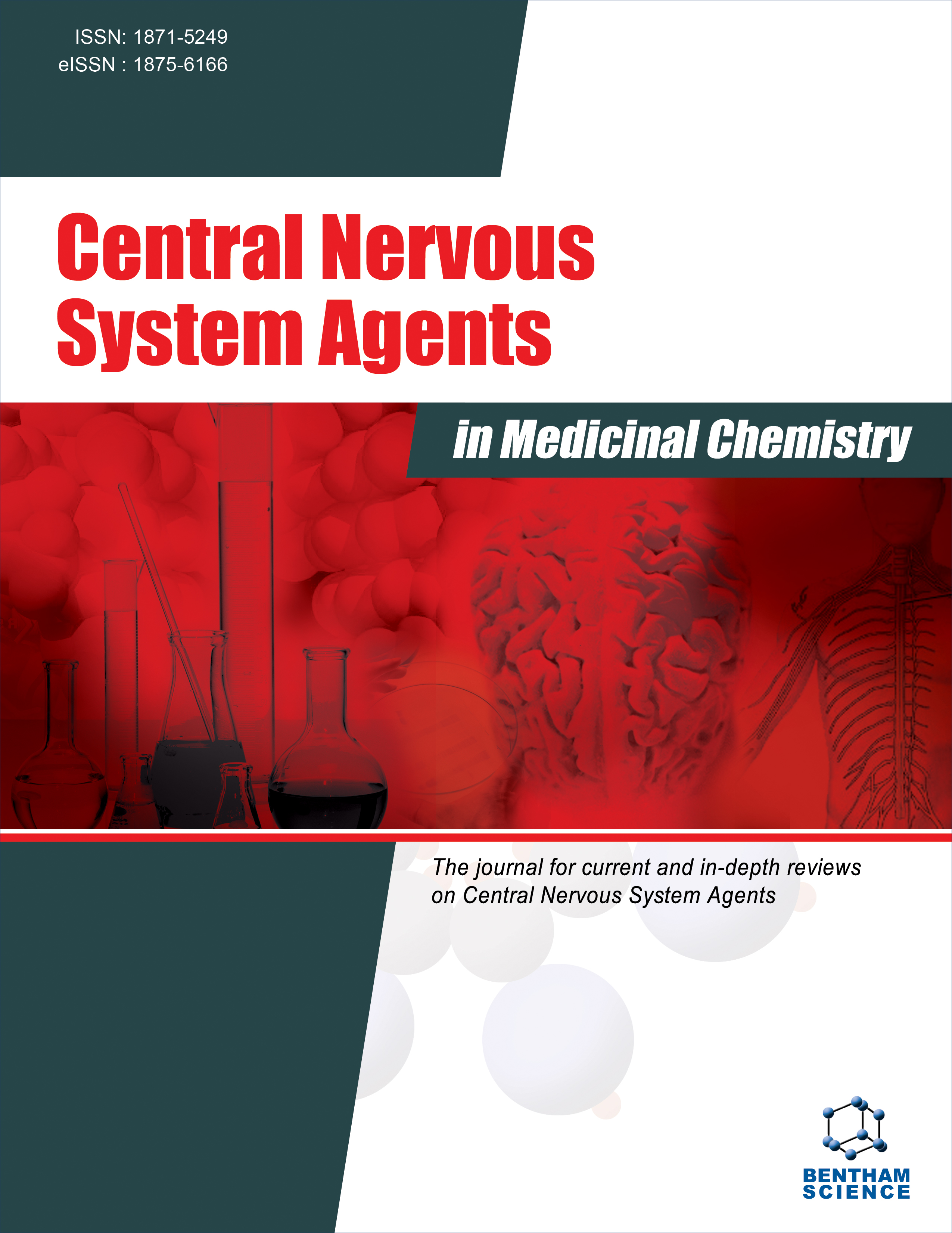- Home
- A-Z Publications
- Central Nervous System Agents in Medicinal Chemistry (Formerly Current Medicinal Chemistry - Central Nervous System Agents)
- Previous Issues
- Volume 21, Issue 2, 2021
Central Nervous System Agents in Medicinal Chemistry (Formerly Current Medicinal Chemistry - Central Nervous System Agents) - Volume 21, Issue 2, 2021
Volume 21, Issue 2, 2021
-
-
Statistical Review of the Suicide Attempts Rates Committed on Polish Railway Tracks between the Years 2013-2016
More LessSuicides on railway tracks are one of the most drastic ones. No research concerning this phenomenon has been conducted to this date in Poland. This article focuses on the connection between suicidal behaviors on Polish railway tracks and sociodemographic traits and presents risk factors. Background: The Incidence of suicide is spread across many European countries. Of these, Poland ranks 22nd in terms of suicide attem Read More
-
-
-
Influence of Inosine on Cerebral Hemodynamics in Space Motion Sickness in Experimental Animals
More LessBackground: Motion sickness occurs worldwide in healthy individuals regardless of age, ethnicity, or gender. It is an acute disorder; it can also present as a chronic disorder in some individuals. Motion sickness not only includes vomiting and nausea, but also includes other features such as pallor of varying degrees, cold sweating, headache, drowsiness, increased salivation, and cranial pain, which are severe. Some of the ot Read More
-
-
-
Concentration-dependent Effects of Dietary L-Ascorbic Acid Fortification in the Brains of Healthy Mice
More LessAuthors: Anthony T. Olofinnade, Adejoke Y. Onaolapo and Olakunle J. OnaolapoBackground: Ascorbic acid (AA) is a water-soluble vitamin that is concentrated in the brain in large quantities. There have been reports that it is essential for proper brain functioning. However, there is insufficient information on the possible effects of dietary fortification with AA on the health of the brain. Objective: This study examined the effects of dietary fortification of rodent chow with AA on neurobehaviour, antioxidant st Read More
-
-
-
Anti-depressant, Anxiolytic, and the Muscle Relaxant Activity of Hydroalcoholic Extract of Cissampelos pareira Linn. Leaves
More LessAuthors: Mohammad Asif, Jayesh Dwivedi and Sandeep YadavBackground: The ethnopharmacological relevance suggests that the ethnic minorities of India use leaves of Cissampelos pareira L. as a traditional medicine for curing various psychopharmacological disorders. Objective: To evaluate anti-depressant, anxiolytic, and muscle relaxant activity of hydro-alcoholic extract of Cissampelos pareira. Methods: Leaves of Cissampelos pareira were extracted using a hydro-alcoholic solvent. Read More
-
-
-
Anti-convulsive Effect of Thiamine and Melatonin Combination in Mice: Involvement of Oxidative Stress
More LessBackground: Epilepsy, the second most frequent neurological disease, is a chronic disorder with a high lifetime prevalence. Therefore, various studies are needed to find new effective therapeutic agents to treat seizures or prevent their complications. In this study, we investigated the effects of thiamine, melatonin and their combination on pentylenetetrazol (PTZ)-induced tonic-clonic seizures in mice. Methods: Male mi Read More
-
-
-
Synthesis, Molecular Docking, and Biological Evaluation of Some Novel 2- (5-Substituted 1,3,4-oxadiazole-2-yl)-1,3-benzothiazole Derivatives as Anticonvulsant Agents
More LessAuthors: Sukhbir L. Khokra, Simranjeet Kaur, Sahil Banwala, Karan Wadhwa and Asif HusainBackground: Benzothiazole is an organosulfur heterocyclic compound that has a considerable place in drug discovery due to significant pharmacological actions. Objective: The main objective of the present study was to synthesize some novel 2-(5-substituted 1,3,4-oxadiazole-2-yl)-1,3-benzothiazole derivatives and evaluate them for their anticonvulsant activity using in silico and in vivo methods. Methods: A set of Read More
-
-
-
Effects on the Post-translational Modification of H3K4Me3, H3K9ac, H3K9Me2, H3K27Me3, and H3K36Me2 Levels in Cerebral Cortex, Hypothalamus and Pons of Rats after a Systemic Administration of Cannabidiol: A Preliminary Study
More LessBackground: Cannabidiol (CBD), a non-psychotropic constituent of Cannabis sativa, has shown therapeutic promises by modulating several pathological conditions, including pain, epilepsy autism, among others. However, the molecular mechanism of action of CBD remains unknown and recent data suggest the engagement on CBD´s effects of nuclear elements, such as histone activity. Aim: This study assessed the chang Read More
-
-
-
Protective Effect of Capparis spinosa Extract against Focal Cerebral Ischemia-reperfusion Injury in Rats
More LessBackground: Ischemic stroke is a serious public health problem. Despite extensive researches focusing on the area, little is known about novel treatments. Objective: In this study, we aimed to investigate the effects of Capparis spinosa (C. spinosa) extract in the middle cerebral artery occlusion (MCAO) model of ischemic stroke. Methods: Wistar rats underwent 30-min MCAO-induced brain ischemia followed by 24 h of r Read More
-
Volumes & issues
-
Volume 25 (2025)
-
Volume 24 (2024)
-
Volume 23 (2023)
-
Volume 22 (2022)
-
Volume 21 (2021)
-
Volume 20 (2020)
-
Volume 19 (2019)
-
Volume 18 (2018)
-
Volume 17 (2017)
-
Volume 16 (2016)
-
Volume 15 (2015)
-
Volume 14 (2014)
-
Volume 13 (2013)
-
Volume 12 (2012)
-
Volume 11 (2011)
-
Volume 10 (2010)
-
Volume 9 (2009)
-
Volume 8 (2008)
-
Volume 7 (2007)
-
Volume 6 (2006)
Most Read This Month
Article
content/journals/cnsamc
Journal
10
5
false
en


